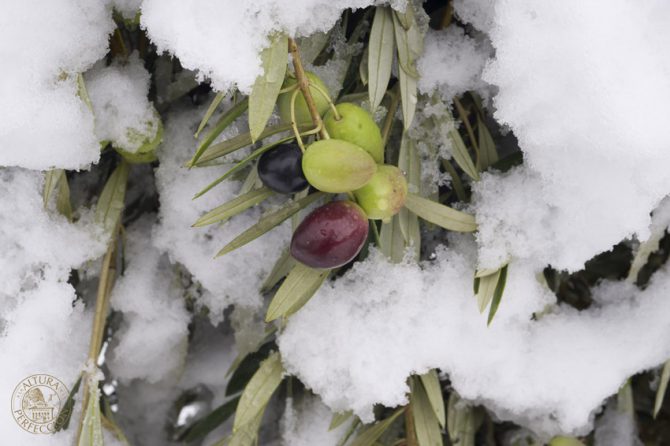
Olive-growing at Masía El Altet to produce the best olive oil in the world
The influence of climatology and care applied to olive trees to obtain extra virgin olive oils of extremely high quality
Olive-growing in a particular territory is of great importance to extract the best high quality extra virgin olive oil. Olive-growing is the combination of techniques and knowledge applied to the cultivation of the olive. It also refers to climatology, the land and also includes aspects such as planting, pruning, grafting …
So, what are the external factors which mean that we can talk about a high quality olive oil? What techniques are applied? What is olive-growing?
What is certain is that there are many and what is of greatest importance is that there are a combination of factors linked to the land and to the vintage. These depend in their entirety on Mother Nature and cannot be controlled by humans but it is obvious that they form part of this activity of olive-growing
On the other hand, the care and attention given by the grower, irrigation, pruning, grinding, the length and temperature of shaking, the way in which the olives are harvested, the organization of planting, investment in machinery, the moment the fruit is picked are also determining factors within the activity of olive-growing in order to obtain máximum quality. These factors can be controlled by Man.
In this post, we are going to talk about these external factors. We will analyse what temperature range is and how it affects the olive grove. We will explain how altitude can be a decisive aspect in obtaining the best extra virgin olive oil.
And we will obviously look at the land and within this section, we will analyse the soil, the climate, the variety of olive and also the role of Man.
All of these are key aspects if we want to obtain ‘’Premium’’ , the best extra virgin olive oil.
Olive-growing at Masía El Altet: location and climatology
The olive groves of Masía El Altet are to be found at a distance of 30 kms as the crow flies from the Mediterranean and, at the same time, at an altitude of 850 m above sea level.
The particular area, the terrain, the quality of the soil, the microclimate, temperature, relative humidity and altitude all play their part in helping to obtain an extra virgin olive oil with organoleptic characteristics different from the rest.
In our case, early frosts in autumn can be a handicap for our olive-growing if we compare it with other places in Spain. The optimum moment for collecting the olive called pre-ripening time falls at the end of October and beginning of November. In the greater part of Spain, this happens at the beginning of October, when the temperatures are warmer.
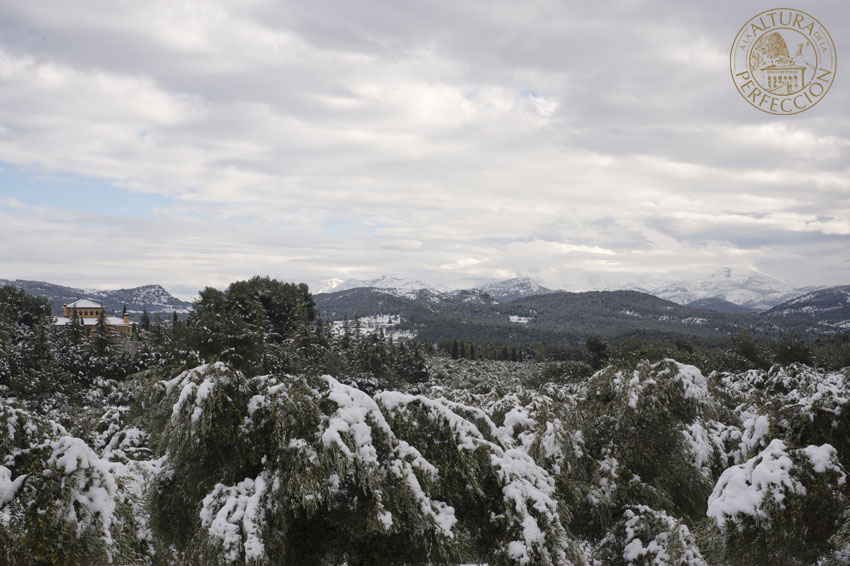
Snowfall on the 8th day of harvesting. November 2013.
Harvesting time at Masía El Altet lasts 10 days. We are going to start now to explain all the factors which make up our activity of olive-growing, beginning with temperature range
What is temperature range and how does it influence olive-growing?
Temperature range or fluctuation in temperature is the first of the factors which we are going to analyse. It determines when we can talk about quality olive-growing. But what is it?
It is very simple and in general terms, it is the difference which exists between the maximum and minimum temperature in one place. Or to put it another way, the maximum and the minimum which exist in a specific period of time, which could be a day or even a year.
We can also register the maximum temperature in summer and the minimum in winter.
For example, at Masía El Altet, in summer months, there are frequently days when the the coolest temperatures in the early hours of the morning are around 10º and the hottest around 30º. In this case, the difference in temperature is 20º.
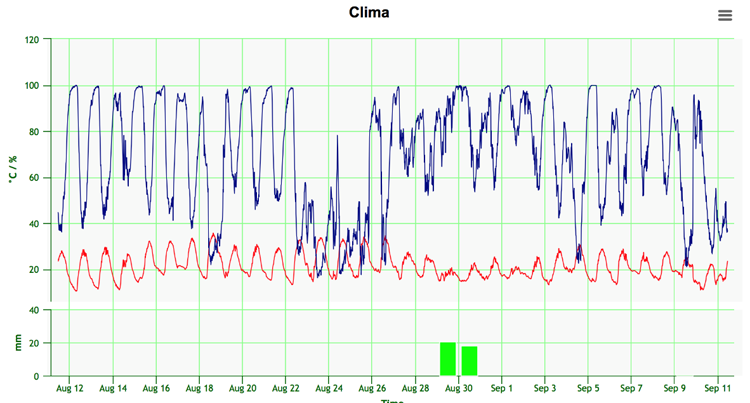
In this graph, we can see from 12th August to 11th September 2017, the enormous fluctuations in temperature (in red) and relative humidity (in blue) between day and night registered in Masía El Altet’s olive groves.
We could define ours as a continental climate of Mediterranean influence, with sudden changes in temperature between the day and night.
Factors which influence maximum and minimum temperatures
Maximum and minimum temperatures are conditioned by many factors. Among them we have the following:
- Relative humidity
- Winds and breezes
- Clear days and cloudy ones
- The altitude at which the olive groves are to be found
- The disposition of the olive grove
- Proximity to water, be it sea water or from a lake or river
- Latitude and longitude of the land in question
- Rainfall patterns
- Work carried out in the olive groves
- Layout which can produce shadows on the branches
In this way, we can compare temperature range taking into account the differences between two different areas but at the same altitude. The differences found in the two sets of data will be called temperature range due to latitude. Or we can carry out comparisons in areas at a differnct altitude. In this case, we would call it temperature range due to altitude.
Having this previous information, we can find temperature range originating from two types of different locations. The first example could be in Patagonia, Argentina, where in many of its smaller localized areas, we will find very hot days and cool nights. This would be a case of temperature range due to latitude.
The second example, in the valleys of the Calchaquíes de Salta, at an altitude of some 2,550 m, we will find the same effect but here, it would be called temperature range due to altitude.
Temperature range and sugar generation
A very marked range of temperature means that the olive tree will produce a greater quantity of sugars.
At night time, its metabolism is at rest, that is to say, it does not need to carry out any kind of effort. This means that the sugars which the olive has produced during the day are not breathed in during the night and in this way, the plant accrues greater concentrations.
The lower the temperature, the less photosynthetic activity there is.
In the olive tree, both water and compost are factors which ‘help’ to produce maximum photosynthesis. But we can’t prevent night time breathing. What does have a bearing here is that if there is a fixed range of temperature, watering and stress have an influence on quality.
What we see here is a slower ripening process between day and night. What is the consequence? The olives are of higher quality. Little by little, they reach the levels of a uniform compound, necessary for the olive oil to be later produced.
Here, we have to say that if the heat of the day does not contrast with the cold of the night, the objective of excellence will not be reached and the olive oil will not be of the same quality.
With high relative humidity and temperatures below 29ºC, the tree functions to perfection, it grows. If, besides this, we give it the water it needs, growth will be even greater.
The synthesis of the oil begins above all, when the stone has hardened.The oil is formed from the sugars. These in turn, come from the photsynthetic activity of the plant, that is to say, we will increase the synthesis of the oil if we maximize the days in which the plant achieves the maximum photosynthetic activity.
How to achieve máximum photosynthetic activity within olive-growing
We know that when photosynthetic activity reaches its peak, it does not increase with more water and in the case of the olive, we run the risk that by watering more than necessary, there is a greater possibility of oxidation of the oil, something which we do not want.
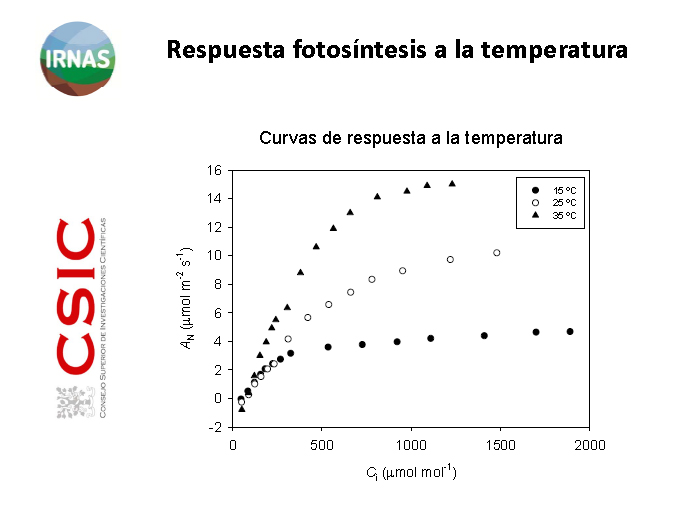
Once we understand this, we can start to carry out what is called controlled water stress on the olive tree. In this way, the tree will grow little or stays at the same level for a certain number of days and when, shortly after, in a controlled way, we put the tree under stress, growth drops off, this time for only one day. We carry out this process when the so-called hardening of the stone has taken place.
Olive-growing and technology
Without technology, it is impossible to understand tree behaviour exactly. In order to measure tree growth, w will use a dendrometer. We will place it in the trunk at knee height. Masía El Altet uses the latest technology for monitoring and control to have minute by minute information about the state of the tree.
Something which is quite curious is that the flowering of our trees is possibly one of the latest in the whole of Spain. It occurs in June when in the rest of Spain in that same month, we will already find well developed olives on the trees.
This difference is due to the fact that our climate is quite a lot colder than in the rest of typical Spanish olive-producing areas.In winter, we can easily register temperatures of minus 8Cº and even have 4 or 5 snowfalls in a year.
For that reason, in olden times, when electricity still didn’t exist, the famous snow pits were built. Pits dug out of the earth, with contention walls, some even roofed. In these, the snow which fell in winter was stored, it was pressed together and to maintain it, layers of straw from corn and barley were added. Later, the ice produced was sold in the hot months. The natural parks which surround us, the Font Roja and the Sierra de Mariola have several snow pits in a reasonable state of conservation.

Snow pit in Sierra de Mariola
Cava Gran, to be found in Sierra de Mariola, circular in shape with a hexagonal outer form, has a capacity of 1,960 cubic metres. It is 12 metres deep and has an interior diameter of 15 metres.
The importance of temperature in olive-growing at Masía El Altet
Is such a low temperature damaging for the olive tree? Yes, but since these temperatures are registered only at a particular moment in the day, they don’t affect the whole of the tree.
If the temperature of -8ºC were to be registered during the whole day, the problem would indeed be serious, possibly resulting in the death of the plant.
At Masía El Altet, we replant some 200 olive trees every year, substituting those which haven’t survived the winter cold, which have been damaged by the harvesting machinery or which have suffered other problems.
In order to reach the quality of the best olive oil, there must also exist a difference in temperature between the different seasons of the year. The tree needs to have a dormant period during the winter, sprout in spring, have fruit growth in summer and ripen in autumn. Autumn will also be the optimum time for harvesting.
All of this must follow the same cycle so that the level of sugars, aromatic components, polyphenols and fatty acids have the same level.
To sum up, for there to be an optimum dormant period, the winter must be cold, the summer, warm to quite hot and spring and autumn must have the typical temperatures of those seasons, for as long a time as possible and without sudden changes from one season to another.
The scenario if temperatures went haywire
What would happen if the temperature range was not as expected? What would happen if temperatures went haywire? We would obviously have another set of results.
For the olive tree, an excess of heat could endanger its growth as well as its production with this risk being even higher if it is accompanied by a shortage of water. If during the flowering period there is a spell of very high temperatures lasting several hours and low relative humidity for various days, there could be a problem with pollen fertility since excessive heat could ruin its fertilizing capacity and as a consequence, no fruit would be produced.
And if the temperature is very high during the night, does the tree rest? No. If the tree doesn’t rest, there is a deterioration in polyphenols and aromatic components. And if the nights are very hot, what usually happens is the days are also normally hotter than usual. And if the nights and days are very cold, the consequence is that the tree will remain in a state of lethargy and the ripening of the olives will be impaired.
Other factors in olive-growing
If there is to be a shortage of water, the flowers abort and the functioning of the chlorophylls is seriously affected, the result of which being a general overall weakening.
If the olive tree is faced with high temperatures, low relative humidity and above all, a shortage of water, it tries to protect itself against dehydration by closing the stomas of its leaves through which it normally breathes. If relative humidity falls below 30%, almost 40% of the stoma will shut down.
When this happens, the exchange of gases between plant and atmosphere is also interrupted and photosynthesis stops. The tree stops producing fotosynthetized elements making the energy sources of the tree forced to choose between vegetative growth and that of the fruit.
For that reason, a large number of the olives are not going to survive until the end and will fall from the tree before ripening or will remain very small.
In conclusion, temperature range which we have just explained and which forms part of olive-growing, plays a very important role in obtaining a high quality olive oil. For that reason, at Masía El Altet, we always insist upon the importance of our surroundings in which it is perfectly possible to have days with a temperature range of 20ºC.
However, the process of producing the best olive oils in the world is a combination of factors. Factors which come together under the umbrella of olive-growing. In order to produce quality olive oil it is not only necessary to observe the range in temperature but also many other thngs. And if one of them fails, it endangers the quality of the oil we are looking for.
What is the influence of altitude on the olive groves?
What importance does altitude have in the production of a good olive oil? The belief that the highter the altitude, the better the quality is becoming more widespread but is it true?
The olive tree is a hardened fighter. It can withstand conditions of stress that in other trees would be unimaginable. It withstands low temperatures and high ones also. It puts up with a shortage of water and can be productive from sea level up to an altitude of 1,200 metres.
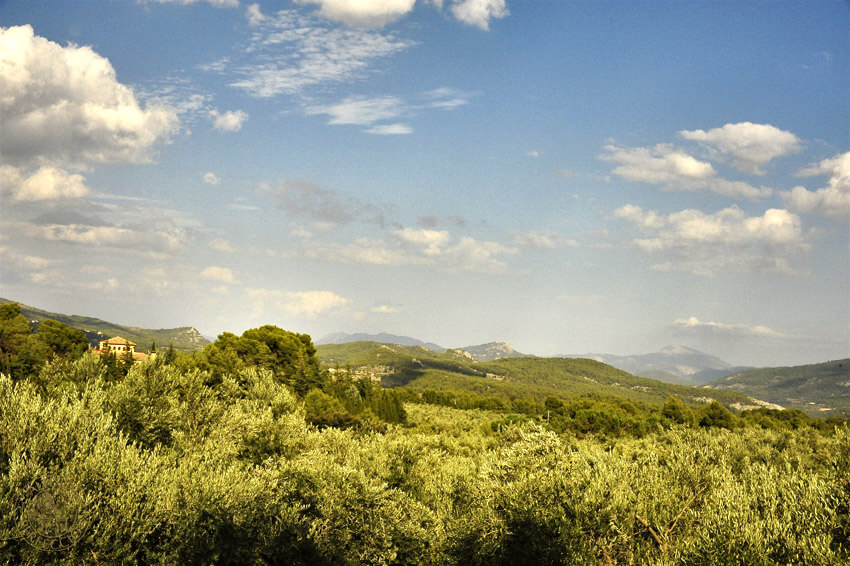
The influence of altitude on olive groves
Picture of Masía El Altet’s olive groves at 850 metres above sea level, in between the Sierra de Mariola and Font Roja natural parks. In the distance, you can see Sierra de Aitana with an altitude of 1,558 metres.
In all of these scenarios, what comes into play is the variety of olive. They can have a short, medium or long ripening period depending on the different conditions of altitude and climate since the olive tree is capable of adapting to all types of conditions. For example, our Genovesa variety of olive ripens more quickly than Picual so the fruit at its optimum moment for harvestting, called the pre-ripening period will appear earlier thus avoiding possible frosts at the time of harvesting.
When it is time to harvest, it is very important to pay great attention to the average temperature between the maximum and minimum during the day. For example, if the average temperature that day is higher than 10ºC, the olive tree will continue in its vegetative process, it will continue working and that is what we do not want.
An average temperature at the moment of harvesting of 10ºC or less which is when the tree is in a dormant state, would be the ideal situation.
The temperature at harvesting time at Masía El Altet
In our case, when harvesting occurs, we normally have temperatures of around 14ºCmaximum and 5ºC minimum, the average temperature/day thus being below 10ºC.
It is at this time that the tree is not developing, it is not working. Therefore, if Mother Nature allows it, harvesting will be perfect. If the average temperature is not 10ºC or below, harvesting will still have to take place since the degree of ripeness of the fruit (the pre-ripening period ) is more important than the average temperature/day. In very few days, the olives will change their pigmentation in the ripening process.
For every 100 metres of altitude gained, the average temperature goes down 0.8ºC. As the altitude increases, so does the level of exposure to sunlight. This is due to the fact that there is less resistence to the entry of the sun’s rays. The higher the altitude, the greater the number of rays. At the same time, the range of temperature necessary to obtain a quality product is also being achieved.
Many growers, due to climate change and to the subsequent increase in temperatures, are looking for alternatives for their crops, such as moving to areas higher up.
At altitude, the breezes which are constant, help to keep the tree healthy. If we look at the soil higher up, it tends to be stonier and more permeable, which allows for better drainage and prevents an excess of water accumulating. But, it is very important to look at levels of exposure to sunlight. If they are very high, they can damage the tree.
Factors connected with the land which affect the quality of the oil
The soil
The soil and what is beneath it is what is at the base of the oil and one of the most important factors in olive-growing. From the ground to the tree and from the tree to the olive. The olive tree takes from the ground all that it needs to survive.
As a general rule, the best soil for quality olive-growing has to be deep. In this way, the roots can get down into various layers.
The best soils also have to have a coarse texture so that there exists good drainage. It is not good for there to be an accumulation of excess water. It should never be abundant in the ripening phase because it will have a negative affect on the quality of the product, reducing the number of polyphenols.
The minerals which this soil contains are also important in obtaining a quality oil.What is more, limestone, iron, magnesium or clay contribute in giving the olive oil character.
The highest quality olive oils are obtained from poor soils with a low content in organic matter. They are chalky soils with low humidity and a basic pH. The principal elements which the tree needs are:
- Nitrogen
- Phosphorous
- Potassium
- Iron
- Magnesium
- Etc, etc
Recently, and thanks to the investigation and development carried out by the Verdech Nuevo Campo team led by Rafael Álvarez, we can claim that a plant suffering climate stress takes in more potassium and less nitrate to protect against stoma closure. Physiologically, potassium is fundamental in the opening of stomas, and photosynthesis.
Climate
It is better for the climate to be mild. But it is very important for there to be a marked difference in temperature between day and night. As you will have noticed, we have gone back to the same topic of temperature range which has got to be right to encourage synthesis and the concentration of the various components that make up the olive and which will later go into the olive oil.
It is better for the amount of rainfall to be medium/low so that the olive tree does not develop illnesses caused by an excess of water. Or for the ground to become waterlogged.
At Masía El Altet, average rainfall is about 500 litres per square metre per year.
So that the chromatic components and sugars form correctly, the number of hours of sunlight and and the light that the sun gives to the branches is of vital importance. For that reason, the recommended framework for planting is that which is intensive (7m x 7m).
It is also important to pay attention to the breezes because they can elimimate the excess of humidity and keep the branches healthy thus preventing leaf spot, ‘repilo’.
In winter, when the vegetative recess occurs, it is important to count on the appropriate intervals of low temperatures. In this way, the branches will develop correctly.
Ultimately, if the olive grove is situated in what we would call a border area, so much the better. By that, we mean that a little bit further out and it would be impossible for cultivation to take place.
The olive tree
The olive tree begins to produce high quality fruit from the fifth year onwards. Up to that moment, the tree is concentrating on defining its structure, that is to say, its trunk and branches. Old olive trees are less porductive. It is the tree itself which regulates itself and little by little, offers a greater quantity of olives up to when it reaches approximately 100 years of age when its production starts to decrease.
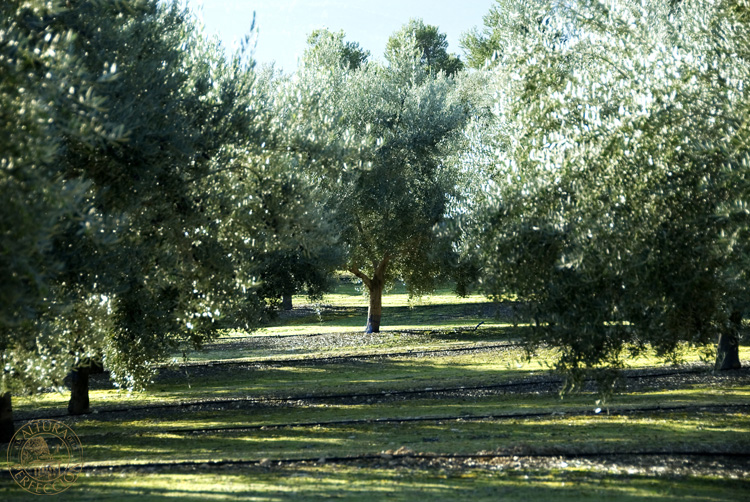
Olive grove at Masía El Altet. 25 years in existence
Here, too, we should take into account that different varieties of olive produce different results. The varieties also depend on their surroundings. And besides, the same varieties do not always have the same level of production since the land provides them with unique qualities. For that reason, there are trees better suited to cooler or more moderate climates.
The role of man in olive-growing
It is Man who is ultimately responsible for the olive grove and who has the last word where decisions are concerned. And these decisions can modify the results which the olives give and consequently, the oil. It is Man who decides how the trees are planted, the number to be planted and how much irrigation he will use. He will also choose the type of fertilizer and the system of pruning. In addition, the composting system, which agricultural products he will use to protect the trees and when.
Once this first agricultural stage has finished, it is now the oil mill’s turn. Here, the cleanliness of the premises, the temperature of grinding and the time of beating, as well as storage in stainless steel vats are elements of extreme importance to bring the cycle to a perfect close and to obtain the best extra virgin olive oil and of the highest quality.
Should olive oil be filtered or not? At Masía El Altet, we are not in favour of doing it. Instead, we let solids settle in stainless steel vats in the form of inverted cones, taking advantage of the base to eliminate water. This is the most natural process.
Another very common method is filtering using filters with a cellulose acetate membrane.
As far as the oil is concerned, in the product, the action of Man bears even more weight because he has to determine what production he wants to obtain from the fruit.
Net oil production in the pre-ripening period can be between 8% and 13% while in the ripening stage, it can be between 13% and 17% approximately.
If the production is higher, we will obtain a greater quantity of oil but of lower quality and the organoleptic qualities will decrease. An excellent setting for a high quality extra virgin olive oil.
The Polop Valley, in the Alcoy municipal area, where Masía El Altet is located, is characterized by the fact that it benefits from a climate ideal for cultivating olive groves, where all of the external factors previously mentioned couldn’t be better adapted and with them, we produce our extra virgin olive oils so that they can be enjoyed with the highest number of polyphenols and antioxidants possible.
